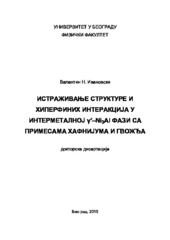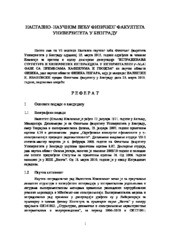Приказ основних података о дисертацији
Истраживање структуре и хиперфиних интеракција у интерметалној y'-Ni3Al фази са примесама хафнијума и гвожђа
Investigation of the structure and hyperfine interactions in the intermetallic y'-Ni3Al phase doped with hafnium and iron
| dc.contributor.advisor | Umićević, Ana | |
| dc.contributor.other | Puzović, Jovan | |
| dc.contributor.other | Spasojević, Đorđe | |
| dc.contributor.other | Belošević-Čavor, Jelena | |
| dc.creator | Ivanovski, Valentin N. | |
| dc.date.accessioned | 2016-07-16T13:15:12Z | |
| dc.date.available | 2016-07-16T13:15:12Z | |
| dc.date.available | 2020-07-03T09:50:22Z | |
| dc.date.issued | 2015-07-16 | |
| dc.identifier.uri | https://nardus.mpn.gov.rs/handle/123456789/5910 | |
| dc.identifier.uri | http://eteze.bg.ac.rs/application/showtheses?thesesId=3175 | |
| dc.identifier.uri | https://fedorabg.bg.ac.rs/fedora/get/o:11524/bdef:Content/download | |
| dc.identifier.uri | http://vbs.rs/scripts/cobiss?command=DISPLAY&base=70036&RID=47674639 | |
| dc.description.abstract | У овом раду истраживана су поликристална интерметална једињења γ′–Ni3Al са примесама атома хафнијума и γ′–Ni3Al са примесама атома гвожђа. Испитивања локалне структуре, магнетних и електричних особина γ′–Ni3Al једињења допираних атомима Hf или атомима Fe извршена су методама дифракције Х–зрачења, мерењима магнетизације, као и применом временски разложених пертурбованих угаоних корелација и спектроскопије Mössbauer–овог ефекта, које су омогућиле истраживања хиперфиних интеракција на језгрима примеса Hf и на језгрима примеса Fe. Ова експериментална истраживања испитиваних система су употпуњена прорачунима енергије дефеката, као и параметара структуре и хиперфиних интеракција на основу првих принципа. Главни циљ експерименталних истраживања и теоријских прорачуна интерметалне γ′– Ni3Al фазе са примесама атома хафнијума, односно гвожђа био је да се одреди преферентно позиционирање атома Hf, односно атома Fe у γ′–Ni3Al решетки, као и њихов утицај на кристалну решетку у коју се уграђују. Aнализoм дифракције Х–зрака испитиваних Hf допираних Ni3Al узорака утврђено је присуство кубне γ′ фазе (ознака L12) у испитиваним Hf–Ni3Al легурама, као и њене две тетрагоналне трансформације L60 и D022. Анализа је показала да је кубна L12 фаза доминантна у односу на тетрагоналне фазе испитиваних Hf–Ni3Al узорака. Мерења хиперфиних интеракција на проби 181Та, језгру–потомку 181Hf, у легурама 0.2, 0.5 и 5 at.% Hf – Ni3Al извршена су у температурском опсегу од 78 K до 1230 K. Измерене вредности хиперфиних параметара приписане су одређеним позицијама атома Hf у присутним Ni3Al фазама: L12, D022 и L60. Присуствo 181Ta–сигнала који је константан у времену кореспондира атомима Hf на позицији Al атома у доминантној L12 фази. За све три испитиване легуре, измерена нижа вредност спин независне електричне iii квадруполне фреквенције додељена је електричној квадруполној интеракцији која дејствује на атоме Hf који су заменили атоме Al у тетрагоналној D022 фази. Измерена виша вредност фреквенције кореспондира атомима Hf на позицијама атома Al у тетрагоналној L60 фази. Резултати прорачуна параметара хиперфиних интеракција, електронских и структурних особина Hf–Ni3Al легура из првих принципа изведених методом проширених равних таласа са локалним орбиталама коришћењем WIEN2k (“An Augmented Plane Wave Plus Local Orbitals Program”) кода коректно репродукују вредности добијене у експерименталним мерењима. Прорачуни енергије дефеката базирани на теорији функционала густине изведени су VASP (“the Vienna ab–initio simulation package”) кодом. Прорачунате електронске структуре проба у разматрању са тачкастим групама симетрије њихових позиција помогли су у идентификовању порекла хиперфиних интеракција и утврдили да је преферентна позиција хафнијума на позицији коју заузимају атоми Al у Ni3Al. Карактеризација узорака γ′–Ni3Al допираних гвожђем извршена је дифракцијом Х–зрачења и мерењима магнетизације. Локална електронска и магнетна структура, хиперфине интеракције пробе 57Fe, као и фазни састав легура Ni2.82Fe0.18Al и Ni2.64Fe0.36Al истражени су спектроскопијом Mössbauеr–овог ефекта. Резултати прорачуна електронских особина Fe–Ni3Al легура из првих принципа методом пројектора проширених таласа као и резултати прорачуна енергије дефеката објашњавају електронску структуру, хиперфине интеракције и преферентну позицију атома Fe у легури γ′–Ni3Al са мањком никла. Вредност израчунате највеће компоненте тензора градијента електричног поља, Vzz = 1.6 1021 Vm-2 на основу вредности параметара добијених из Mössbauеr–ових спектара, указује да у обе испитиване легуре атоми гвожђа замењују атоме никла у γ′–Ni3Al. | sr |
| dc.description.abstract | The dissertation addresses the local crystal structure and hyperfine interactions of hafnium or iron doped polycrystalline intermatallic γ′–Ni3Al alloys. The local structure, magnetic and electrical properties of γ′–Ni3Al compounds doped with Hf atoms or Fe atoms were investigated by the X ray diffraction, magnetization, time differential perturbed angular correlation spectroscopy and Mössbauer–effect spectroscopy. The last two experimental methods provided insight into hyperfine interactions of Hf– and Fe–nucleus. This was complemented by the calculations of the energy of the defects, as well as with ab initio calculations of structural and hyperfine interactions parameters. The main goal of the experimental and theoretical investigations of the intermetallic γ′–Ni3Al phase doped with Hf or Fe atoms was to determine the site preference of dopant atoms in the γ′–Ni3Al matrix, as well as their influence on the host lattice. The X–ray diffraction measurements of the Hf doped Ni3Al samples revealed the presence of the cubic γ′ phase (usually denoted by L12) and its two tetragonal distortions: D022 and L60. The refinement of XRD data showed the dominant presence of the cubic L12 phase in the Hf–Ni3Al samples, with the minority presence of the two tetragonal phases. The measurements of the hyperfine interactions of the 181Та–probe in the 0.2, 0.5 and 5 at.% Hf – Ni3Al alloys (181Та–nucleus is the daughter–nucleus of the 181Hf–parent nucleus) were done in the temperature range 78 K to 1230 K. The measured hyperfine parameters values were assigned to the various Hf atom sites in the different crystal structures (cubic and tetragonal) present in the Ni3Al alloys. The presence of 181Та–signal constant in time is ascribed to Hf atoms at the Al sites in dominant L12 phase. For all investigated alloys, the lower value of the spin independent electric quadrupole frequency was ascribed to the electric quadrupole interaction of the Hf nuclei substituting on the Al sites in the tetragonal D022 phase in the Hf–Ni3Al v alloys. The higher value of the spin independent electric quadrupole frequency corresponded to the electric quadrupole interactions of the Hf nuclei substituting on the Al sites in the tetragonal L60 phase in the Hf–Ni3Al alloys. The ab initio calculations of electronic and structural properties and hyperfine parameters of the 181Ta ion probe in the Hf–Ni3Al alloys, performed using the full potential augmented plane wave plus local–orbital method as implemented in the WIEN2k code, correctly reproduce the experimental results. The DFT (density functional theory) calculations of point defect energies were done by using the Vienna ab initio simulation package VASP. The ab initio calculations enable discussion on the structural and electronic properties of the Ni3Al polycrystalline alloys. The joint experimental and theoretical investigations enabled us to identify the observed hyperfine interactions and showed that hafnium additions prefer aluminum sites in Ni3Al. The structural and magnetic characterizations of the Fe doped γ′–Ni3Al samples were done by the X–ray diffraction and magnetization measurements. The local electronic and magnetic structure, the hyperfine interactions of the 57Fe–probes, as well as the phase composition of the Ni2.82Fe0.18Al and Ni2.64Fe0.36Al alloys were investigated by means of the Mössbauer–effect spectroscopy. The ab initio calculations performed with the projector augmented wave method and the calculations of the energies of iron point defects were done to elucidate the electronic structure, the hyperfine interactions and site preference of Fe doped Ni–deficit γ′–Ni3Al. The value of calculated electric field gradient tensor Vzz = 1.6 1021 Vm-2 matches well with the results of Mössbauer spectroscopy and indicates weak preference of iron dopant atoms for Ni sites. | en |
| dc.format | application/pdf | |
| dc.language | sr | |
| dc.publisher | Универзитет у Београду, Физички факултет | sr |
| dc.relation | info:eu-repo/grantAgreement/MESTD/Integrated and Interdisciplinary Research (IIR or III)/45018/RS// | |
| dc.rights | openAccess | en |
| dc.rights.uri | https://creativecommons.org/licenses/by-nc-nd/4.0/ | |
| dc.source | Универзитет у Београду | sr |
| dc.subject | Ni3Al | sr |
| dc.subject | Ni3Al | en |
| dc.subject | hyperfine interactions | en |
| dc.subject | Mössbauer spectroscopy | en |
| dc.subject | PAC spectroscopy | en |
| dc.subject | site preference | en |
| dc.subject | хиперфине интеракције | sr |
| dc.subject | Mössbauer–ова спектроскопија | sr |
| dc.subject | PAC спектроскопија | sr |
| dc.subject | преферентне позиције атома | sr |
| dc.title | Истраживање структуре и хиперфиних интеракција у интерметалној y'-Ni3Al фази са примесама хафнијума и гвожђа | sr |
| dc.title | Investigation of the structure and hyperfine interactions in the intermetallic y'-Ni3Al phase doped with hafnium and iron | en |
| dc.type | doctoralThesis | en |
| dc.rights.license | BY-NC-ND | |
| dcterms.abstract | Умићевић, Aна; Пузовић, Јован; Спасојевић, Ђорђе; Белошевић-Чавор, Јелена; Ивановски, Валентин Н.; Istraživanje strukture i hiperfinih interakcija u intermetalnoj y'-Ni3Al fazi sa primesama hafnijuma i gvožđa; | |
| dc.identifier.fulltext | https://nardus.mpn.gov.rs/bitstream/id/24957/Disertacija3736.pdf | |
| dc.identifier.fulltext | https://nardus.mpn.gov.rs/bitstream/id/24958/Ivanovski_Valentin_referat_disertacija_FIF.pdf | |
| dc.identifier.fulltext | http://nardus.mpn.gov.rs/bitstream/id/24957/Disertacija3736.pdf | |
| dc.identifier.fulltext | http://nardus.mpn.gov.rs/bitstream/id/24958/Ivanovski_Valentin_referat_disertacija_FIF.pdf | |
| dc.identifier.rcub | https://hdl.handle.net/21.15107/rcub_nardus_5910 |



